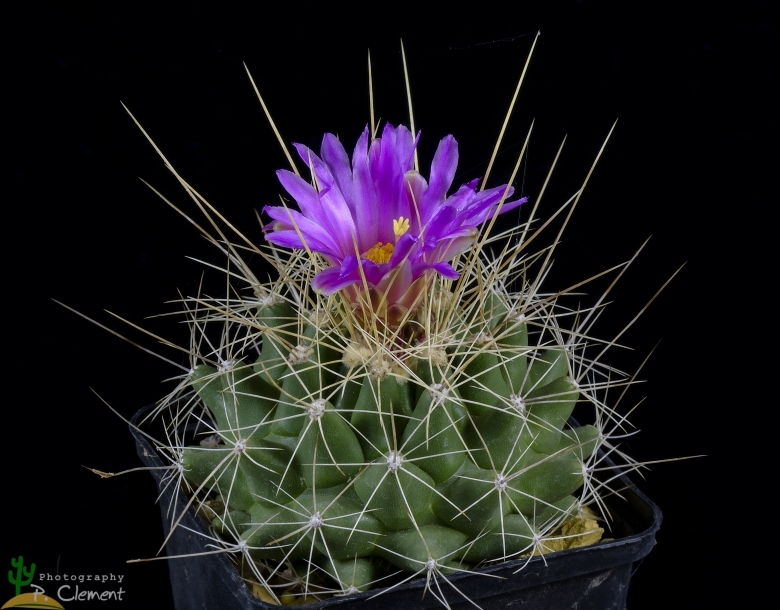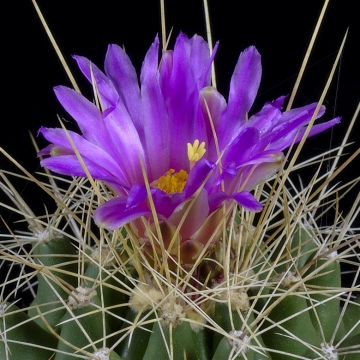Accepted Scientific Name: Thelocactus tulensis subs. matudae (Sánchez-Mej. & A.B.Lau) N.P.Taylor
Cactaceae Consensus Init. 5: 14. 1998

Thelocactus buekii subs. matudae (Thelocactus tulensis subs. matudae) Photo by: Peiffer Clement
Synonyms:
See all synonyms of Thelocactus tulensis
back
Accepted name in llifle Database:Thelocactus tulensis (Poselg.) Britton & RoseCactaceae (Britton & Rose) 4: 11, fig. 10. 1923Synonymy: 10
Accepted name in llifle Database:Thelocactus tulensis subs. buekii (E.Klein bis) N.P.TaylorCactaceae Consensus Init. 5: 14. 1998Synonymy: 6
Accepted name in llifle Database:Thelocactus tulensis subs. matudae (Sánchez-Mej. & A.B.Lau) N.P.TaylorCactaceae Consensus Init. 5: 14. 1998Synonymy: 7
Accepted name in llifle Database:Thelocactus tulensis subs. vaskoanus (Halda, Hovorka & Zatloukal) Halda, Kupčák & MalinaActa Mus. Richnov., Sect. Nat. 9(1): 45. 2002Synonymy: 2
back
Description: Thelocactus tulensisSN|1065]]SN|1065]] subsp. matudae is a globular cactus closely related to Thelocactus tulensisSN|1065]]SN|1065]] subsp. buekii, but with distinctive longer tubercles, higher spine number and larger flowers. Both taxa are subspecies of the very variable polymorphic Thelocactus tulensisSN|1065]]SN|1065]] which comprises innumerable geographical forms linked one to each others by populations of plants with intermediate characteristics. Such variations has led to establishment of several unnecessary names for this species.
Habit: Thelocactus tulensisSN|1065]]SN|1065]] subsp. matudae is a solitary geophyte stem succulent.
Stem: Depressed to globose 5-22 cm tall,11-16 in diameter, glaucous green to dark brown or magenta.
Ribs: Indistinct and completely divided into tubercles.
Tubercles: Broad, 1,5-3 cm long, conical more or less angular in cross section.
Areoles: 2-9 mm long, 2-6 mm wide, 12-35 mm apart, with partially developed grooves,
without extrafloral nectaries.
Central spines: 3 to 7 grey to reddish vertical and stright, up to 2 cm.
Radial spines: 7 to 12 radiatimg..
Root system: Fat underground tap root.
Flowers: Diurnal Bright purplish-pink to purple, up to 8 cm wide
Blooming season: Early summer.
Subspecies, varieties, forms and cultivars of plants belonging to the Thelocactus tulensis group
- Thelocactus buekii subs. jarmilae Halda & Horáček: smaller size and flowers.
- Thelocactus santaclarensis Halda, Kupčák & Sladk.: bueckii/matudae intermediate form. With rose flowers
 Thelocactus tulensis (Poselg.) Britton & Rose: (ssp. tulensis) Usually branched and with distinct and vertical ribs, round or somewhat pyramidal tubercles, and white flowers; it is the most southern and common, occurring in Tamaulipas and San Luis Potosi at elevations of 1100-1400 m.
Thelocactus tulensis (Poselg.) Britton & Rose: (ssp. tulensis) Usually branched and with distinct and vertical ribs, round or somewhat pyramidal tubercles, and white flowers; it is the most southern and common, occurring in Tamaulipas and San Luis Potosi at elevations of 1100-1400 m. Thelocactus tulensis subs. buekii (E.Klein bis) N.P.Taylor: Usually solitary it has poorly developed or no ribs, more or less pointed, angled tubercles, and magenta flowers; it is centrally located. Distribution: Nuevo Leon at 1200-1800 m.
Thelocactus tulensis subs. buekii (E.Klein bis) N.P.Taylor: Usually solitary it has poorly developed or no ribs, more or less pointed, angled tubercles, and magenta flowers; it is centrally located. Distribution: Nuevo Leon at 1200-1800 m. Thelocactus tulensis subs. matudae (Sánchez-Mej. & A.B.Lau) N.P.Taylor: Usually solitary with indistinct ribs, variable tubercles that are usually conical but somewhat angular in cross section and purplish pink flowers. Distribution: it is the most northern, found in Nuevo Leon at 800-1000 m.
Thelocactus tulensis subs. matudae (Sánchez-Mej. & A.B.Lau) N.P.Taylor: Usually solitary with indistinct ribs, variable tubercles that are usually conical but somewhat angular in cross section and purplish pink flowers. Distribution: it is the most northern, found in Nuevo Leon at 800-1000 m. Thelocactus tulensis subs. matudae f. variegatus hort.
Thelocactus tulensis subs. matudae f. variegatus hort.
Bibliography: Major references and further lectures
1) Edward F. Anderson, Salvador Arias Montes, Nigel P. Taylor, Andrea Cattabriga “Threatened cacti of Mexico” Royal Botanic Gardens, Kew, 1994
2) Edward Anderson “The Cactus family” Timber Press, Incorporated, 2001
3) James Cullen, Sabina G. Knees, H. Suzanne Cubey "The European Garden Flora Flowering Plants: A Manual for the Identification of Plants Cultivated in Europe, Both Out-of-Doors and Under Glass" Cambridge University Press, 11/Aug/2011
4) David R Hunt; Nigel P Taylor; Graham Charles; International Cactaceae Systematics Group. "The New Cactus Lexicon" dh books, 2006
5) N. L. Britton, J. N. Rose “The Cactaceae. Descriptions and Illustrations of Plants of the Cactus Family.” Volume 4, The Carnegie Institution of Washington, Washington 1923,
6) Curt Backeberg: “Die Cactaceae: Handbuch der Kakteenkunde” Volume V, Gustav Fischer Verlag, Stuttgart New York 1982–1985
 Thelocactus buekii subs. matudae (Thelocactus tulensis subs. matudae) Photo by: Peiffer Clement
Thelocactus buekii subs. matudae (Thelocactus tulensis subs. matudae) Photo by: Peiffer ClementSend a photo of this plant.The gallery now contains thousands of pictures, however it is possible to do even more. We are, of course, seeking photos of species not yet shown in the gallery but not only that, we are also looking for better pictures than those already present.
Read More... Cultivation and Propagation: Thelocactus tulensisSN|1065]]SN|1065]] subsp. matudae is easy to cultivate and recommended for any collection that needs lots of light with ample airflow.
Growth rate: It is a small growing, but easily flowering species. It offset from the base and can fill a 25 cm pot in just a few years given the best conditions.
Soils: It likes very porous standard cactus mix soil with little organic matter (peat, humus).
Repotting: Repotting every 2-3 years. It will need a pot with sufficient depth to allow the tap root. As it is especially prone to rot under-pot in a smaller container filled with very porous compost. Use pot with good drainage.
Watering: Water regularly in summer, but do not overwater (very wet-sensitively, especially in light of its succulent root system). Its roots are easily lost in pots that stay damp for any length of time. Keep dry with ample airflow in winter. In the rest period no high atmospheric humidity!! Care must be taken with watering as they tends to become swollen and untidy in growth habit if given too much water and shade.
Fertilization: During the growing season enrich the soil using a fertilizer rich in potassium and phosphorous, but poor in nitrogen, because this chemical element doesn’t help the development of succulent plants, making them too soft and full of water.
Hardiness: Reputedly sensitive to frost , but less so if kept on the dry side prior to, and during, cold weather (hardy to -7° C for short periods). However some warmth throughout the year will increase the grower's success (minimum 5° to 8°C during rest season).
Exposition: Outside bright sun, filtered sunlight or afternoon shade, inside it needs bright light, and some direct sun. Subject to sunburn if exposed to direct sun for too long. Tends to bronze in strong light, which encourages flowering and heavy wool and spine production.
Uses: It is an excellent plant for container growing. It always looks good and stays small. It look fine in a cold greenhouse and frame.
Pests & diseases: It may be attractive to a variety of insects, but plants in good condition should be nearly pest-free, particularly if they are grown in a mineral potting-mix, with good exposure and ventilation. Nonetheless, there are several pests to watch for:
- Red spiders: Sensitive to red spider mite. Overhead watering is helpful in controlling mites.
- Mealy bugs: Occasionally mealy bugs they develop aerial into the new growth among the wool with disfiguring results, but the worst types develop underground on the roots and are invisible except by their effects.
- Scales: Scales are rarely a problem.
- Rot: Rot it is only a minor problem with cacti if the plants are watered and “aired” correctly. If they are not, fungicides won't help all that much.
Reproduction: Nearly always from seed, since the plant rarely produces plantlets.











